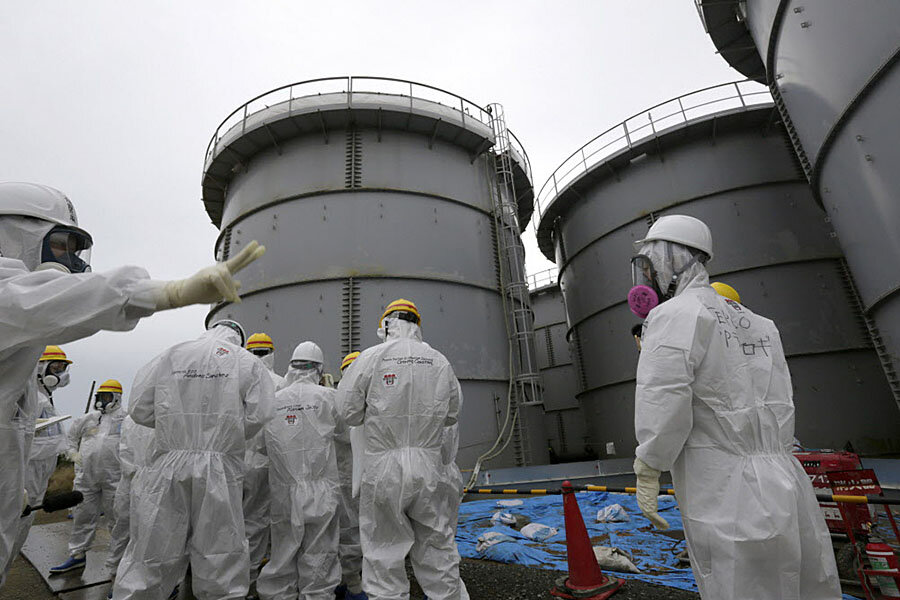Fukushima cleanup: What to do with a torrent of radioactive water
Loading...
More than four years after the catastrophic tsunami that crippled several nuclear reactors in Fukushima, the Japanese utility that owns the site is struggling to deal with a continuous flood of radioactive water.
The tsunami knocked off power at the nuclear plant, which led to the meltdown of three of the six reactors, with a fourth severely damaged. The ongoing release of radioactive material has prevented anyone from entering parts of the complex.
But getting a handle on the mess, let alone permanently cleaning up the site, has been extraordinarily difficult. The problem is the daily flood of rainwater that flows downhill towards the sea, rushing into the mangled radioactive site. An estimated 300 tons of water reaches the building each day, and then becomes contaminated. TEPCO, the utility that owns the site, has been furiously building above ground storage tanks for radioactive water. Storing the water prevents it from being discharged into the sea, but this Sisyphean task does nothing to ultimately solve the problem as the torrent of water never ends. TEPCO has already put more than 500,000 tons of radioactive water in storage tanks. (Related: France’s Areva Lost $5.6 Billion In 2014 – Is This The End?)
To reduce the 300 tons of newly created radioactive water each day, TEPCO must cut off the flow of groundwater into the nuclear complex. To do that, it plans on building an ice wall that will surround the four reactors. TEPCO plans on building an intricate array of coolant pipes underneath the reactors, freezing the soil into a hardened ice wall that will block the flow of water. The ice wall will stretch one and a half kilometers around the reactors.
Great plan, except that it has never been done before. TEPCO may be able to freeze the soil, but there is no telling if it can build an ice wall without any holes that could allow water to seep into the reactor building. Questions surrounding the viability of the ice wall, and with it the prospects for halting the flow of radioactive water, heightened after TEPCO announced in mid-March that it was postponing the project. (Related: China Builds Nuclear Reactors in Earthquake-Prone Pakistan)
In fact, much of what TEPCO has to do to clean up the disaster area is daunting. TEPCO actually has to dig up radioactive soil and remove it, putting it in an interim storage facility. The idea is to make Fukushima inhabitable again, rather than indefinitely leave it as a radioactive and toxic no-go zone like the immediate surroundings of Chernobyl. When or if that can happen is anybody’s guess. The removal of radioactive soil began recently.
Another unnerving challenge is TEPCO’s plan to remove radioactive elements from contaminated water and then discharge the water into the Pacific Ocean, a plan that is facing enormous pushback. That’s because TEPCO has lost the trust of the public. Not only has the utility responded poorly to the cleanup, but it also recently admitted to not having publicly disclosed that a leak was resulting in radioactive water flowing into the ocean. TEPCO knew about the leak for more than ten months, one of a long line of acts of obfuscation that has enraged the Japanese public. The Japanese Nuclear Regulatory Authority gave its stamp of approval for dumping cleansed water into the ocean, but the fishing industry is hoping to block the plan, as many fishermen do not trust that the water TEPCO plans on dumping is in fact clean of radioactivity. (Related: Middle East Oil Addiction Could Spell Disaster)
The Japanese government hopes to prevent future nuclear meltdowns by constructing “The Great Wall of Japan,” a controversial $6.8 billion campaign to build around 440 sea walls along the coast to fend off tsunamis.
That may be able to prevent future disasters, but in the meantime the cleanup and decommissioning of the Fukushima nuclear power plant continues. It could take another forty years before the work is complete.
More Top Reads From Oilprice.com:





